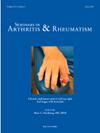New onset work disability in rheumatoid arthritis is an underrecognized cardiovascular risk factor: A retrospective cohort study using the CorEvitas registry
IF 4.6
2区 医学
Q1 RHEUMATOLOGY
引用次数: 0
Abstract
Objectives
Patients with rheumatoid arthritis (RA) are more likely to develop work disability than the general population. We investigated whether individuals younger than 65 years of age who had both RA and new-onset work disability were at higher risk of CVD compared to similarly aged individuals with RA who did not develop disability. We identified the factors that best explained the excess risk.
Methods
This was a retrospective cohort study using data from the CorEvitas RA registry. Patients younger than 65 with RA were included. Exposure was new-onset work disability, and comparator was consistently working individuals. Cohorts were age- and sex-matched. Demographics, medications, and disease specific factors were collected for all patients. Incidence rates (IR) for cardiovascular events were calculated using Poisson regression and explanatory multivariable models were built using Cox proportional hazard ratios (HR) to determine the factors that explained the excess CVD risk.
Results
Age and sex-adjusted IR was 5.40 per 1,000 person-years in the new-onset work disability group compared to 2.17 per 1,000 person-years in the working group. Work disability associated with CVD with HR = 2.32 (95 % CI 1.52, 3.53) in the age- and sex-adjusted model. Multivariate models accounting for functional status, education, medications, and traditional CVD risk factors could not fully explain the excess risk for CVD in newly work disabled patients with RA: HR = 1.78 (1.09, 2.91).
Conclusions
Patients younger than 65 with RA and new-onset work disability are at significantly increased risk for incident CVD compared to working peers. The excess CVD risk remained unexplained after accounting for multiple variables, possibly due to variables we cannot fully account for, such as social determinants of health and allostatic load.
类风湿性关节炎的新发工作残疾是一个未被充分认识的心血管风险因素:一项利用 CorEvitas 登记进行的回顾性队列研究。
目标:类风湿性关节炎(RA)患者比一般人群更容易出现工作残疾。我们调查了同时患有 RA 和新发工作残疾的 65 岁以下人群与未发生残疾的年龄相仿的 RA 患者相比,是否具有更高的心血管疾病风险。我们确定了最能解释超额风险的因素:这是一项利用 CorEvitas RA 登记数据进行的回顾性队列研究。研究纳入了 65 岁以下的 RA 患者。研究对象为新发工作残疾,比较对象为持续工作的人。组群的年龄和性别匹配。收集了所有患者的人口统计学资料、药物和疾病特异性因素。使用泊松回归法计算心血管事件的发病率(IR),并使用考克斯比例危险比(HR)建立解释性多变量模型,以确定解释心血管疾病超额风险的因素:结果:经年龄和性别调整后,新发工作残疾组的IR为每千人年5.40例,而工作残疾组为每千人年2.17例。在年龄和性别调整模型中,工作残疾与心血管疾病相关的 HR = 2.32 (95 % CI 1.52, 3.53)。考虑功能状态、教育程度、药物和传统心血管疾病风险因素的多变量模型不能完全解释新近丧失工作能力的RA患者的心血管疾病超额风险:HR = 1.78 (1.09, 2.91):结论:与有工作的同龄人相比,年龄小于65岁的RA和新发工作残疾患者发生心血管疾病的风险显著增加。在考虑多种变量后,心血管疾病的超额风险仍然无法解释,这可能是由于我们无法完全考虑的变量造成的,如健康的社会决定因素和异质负荷。
本文章由计算机程序翻译,如有差异,请以英文原文为准。
求助全文
约1分钟内获得全文
求助全文
来源期刊
CiteScore
9.20
自引率
4.00%
发文量
176
审稿时长
46 days
期刊介绍:
Seminars in Arthritis and Rheumatism provides access to the highest-quality clinical, therapeutic and translational research about arthritis, rheumatology and musculoskeletal disorders that affect the joints and connective tissue. Each bimonthly issue includes articles giving you the latest diagnostic criteria, consensus statements, systematic reviews and meta-analyses as well as clinical and translational research studies. Read this journal for the latest groundbreaking research and to gain insights from scientists and clinicians on the management and treatment of musculoskeletal and autoimmune rheumatologic diseases. The journal is of interest to rheumatologists, orthopedic surgeons, internal medicine physicians, immunologists and specialists in bone and mineral metabolism.

 求助内容:
求助内容: 应助结果提醒方式:
应助结果提醒方式:


